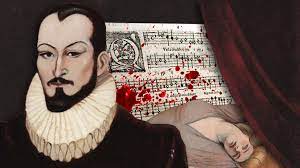Carlo Gesualdo, an Italian Renaissance composer, is known for his intensely expressive and chromatically complex madrigals. His music, full of dramatic contrasts and emotional depth, reflects the turbulent and enigmatic life he led. Here are ten of his most remarkable compositions that showcase his unique style and contributions to the world of music.
1. “Moro, lasso, al mio duolo”
This madrigal from Gesualdo’s sixth book of madrigals is one of his most famous works. It features daring chromaticism and intense emotion, reflecting the anguish and torment of the text. The harmonic progressions in this piece were highly unusual for its time, making it a groundbreaking composition.
2. “Tenebrae Responsoria”
A set of sacred works composed for Holy Week, the “Tenebrae Responsoria” are some of Gesualdo’s most powerful sacred compositions. The music is deeply reflective and haunting, filled with complex harmonies and striking dissonances that evoke the solemnity of the Passion of Christ.
3. “Se la mia morte brami”
Another standout from his fifth book of madrigals, “Se la mia morte brami” is a testament to Gesualdo’s mastery of word painting. The music mirrors the text’s themes of death and despair, with abrupt shifts in harmony and rhythm that heighten the dramatic effect.
4. “Ave, dulcissima Maria”
This sacred motet is one of Gesualdo’s most exquisite pieces of vocal music. It blends intricate polyphony with an expressive, almost mystical use of harmony. The motet is a beautiful example of Gesualdo’s ability to infuse sacred texts with deep emotion.
5. “O vos omnes”
From his “Responsoria et alia ad Officium Hebdomadae Sanctae spectantia,” this sacred piece is another example of Gesualdo’s intense and personal style. The music is somber, with dense harmonic textures that convey the sorrow of the text.
6. “Io parto e non più dissi”
This madrigal, from Gesualdo’s final book, is a perfect illustration of his late style. The piece is marked by sudden changes in tempo, rhythm, and harmony, all of which serve to underline the emotional content of the text. It’s a piece that encapsulates the essence of Gesualdo’s musical innovation.
7. “Sparge la morte al mio signor”
Taken from his fourth book of madrigals, this piece is notable for its use of stark contrasts and intense dissonances. The madrigal is a vivid depiction of sorrow and suffering, showcasing Gesualdo’s ability to translate intense emotional experiences into music.
8. “O crux benedicta”
This sacred motet reflects Gesualdo’s fascination with the themes of suffering and redemption. The piece is both mournful and serene, with a complex harmonic structure that adds to its emotional depth. It’s a perfect example of his skill in writing sacred music.
9. “Dolcissima mia vita”
From the fifth book of madrigals, “Dolcissima mia vita” is a beautiful and melancholic piece that explores the theme of unrequited love. The music is lush and expressive, with intricate vocal lines that intertwine to create a rich tapestry of sound.
10. “Asciugate i begli occhi”
This madrigal, also from the sixth book, is a powerful piece that combines lyrical beauty with harmonic daring. The music mirrors the text’s plea for comfort, with shifting harmonies that evoke a sense of longing and unresolved tension.
Conclusion
Carlo Gesualdo’s compositions are a profound reflection of his inner world, characterized by their bold harmonic language and emotional intensity. These ten pieces provide a glimpse into the mind of one of the Renaissance’s most fascinating composers, whose work continues to intrigue and move listeners today.


Comments are closed